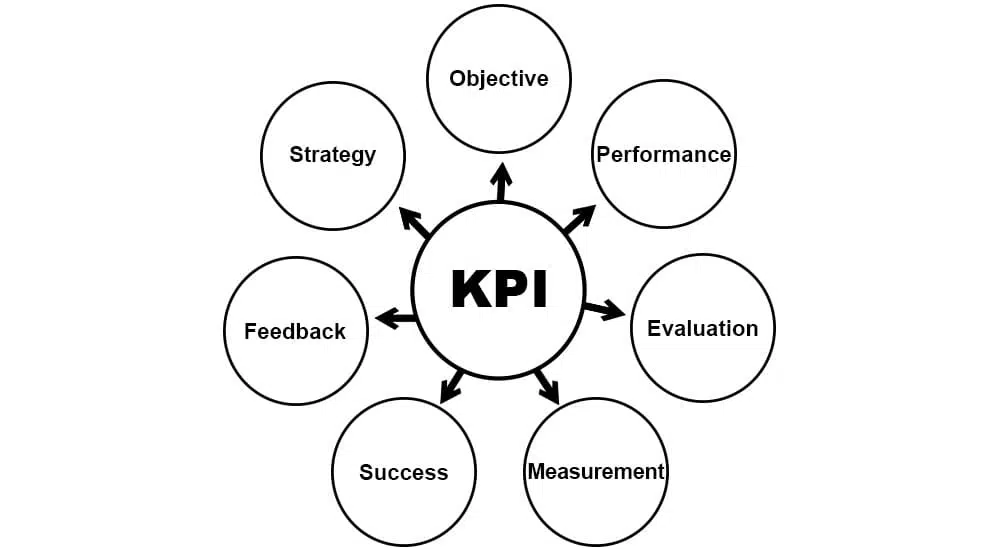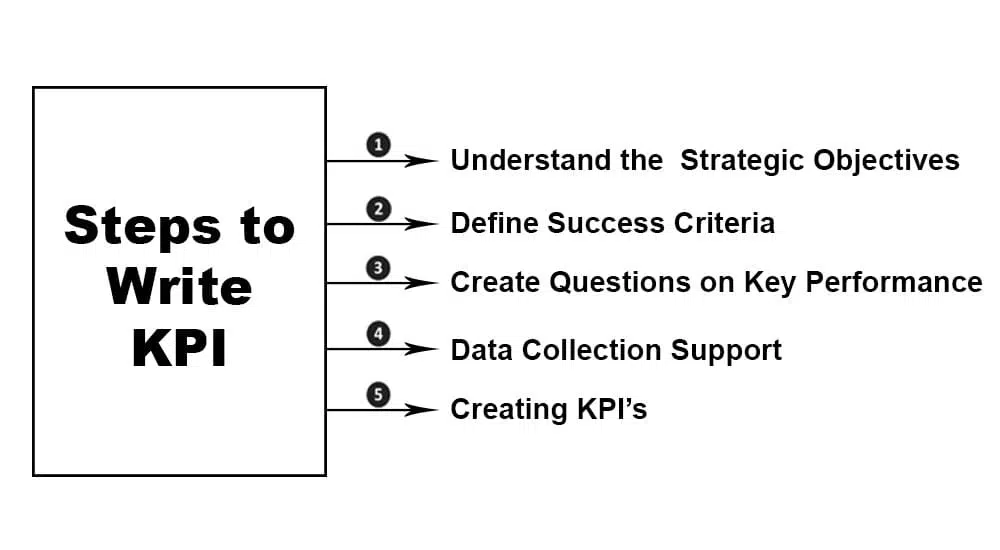KPI stands for Key Performance Indicators, and it is a metric that helps businesses measure their performance. Businesses can use KPIs to see whether they are achieving their objectives and then take data-driven actions to improve their performance.
Definition: Key performance indicators (KPIs) are metrics that organizations use to track and measure the success of their business. Businesses have many KPIs depending on the industry and the requirements.
KPI motivates the team to improve their performance, achieve milestones on time, and measure their progress while achieving the targets. Businesses can define KPIs for different operations areas, find their weaknesses and strengths, and improve the processes with poor performance.
KPIs are unique and specific to the organization’s objectives and goals. Organizations use KPIs to track progress, identify areas of improvement, and make strategic decisions. For example, a company might use KPIs to track progress toward its goal of increasing revenue. Monitoring KPIs lets businesses know if they are on track or need to adjust their strategy.
KPIs are an important tool for small and large organizations. They can help small businesses track progress and decide where to allocate resources. Large organizations can use KPIs to measure progress across multiple departments or business units.
KPI Example
Let us say you are selling toys and set to sell 3,000 toys each month at minimum. This is your KPI. And now, you can watch your KPI to measure the performance every month and take necessary actions if the performance is not as expected.
If you have sold around 2,000 toys in a month during the first two weeks, meaning you will achieve your target, no action is required. But if the sales are low and you have sold only 1000 toys, you will take necessary actions to improve the performance. You can offer sales, rebates, or discounts to increase sales.
Likewise, an organization can set its KPI on sales, profit, production, etc. The KPI can be at a higher or lower level and can be narrowed down to each department’s performance.

KPI Basics
Businesses identify unique factors that are important for their success. After identifying these factors, they select the metrics required to measure them. This step is important, as it tracks progress over time.
Goals and objectives can be set after the KPI and metrics are identified. Businesses can track their progress through KPIs and see whether their objectives and goals have been met. If not, then they can adjust their strategies.
An organization must establish a KPI tracking system that is easy to use and trackable.
What Are the Different Types of KPIs?
You can use many KPIs depending on the industry and your objectives. Some popular KPIs are as follows:
Customer KPIs
Customers are lifelines to the business, and tracking performance related to the customer is vital for business survival and growth.
Some customer-related KPIs are customer satisfaction, retention, average customer lifetime value, customer acquisition cost or CAC (i.e., dividing total acquisition costs by the number of new customers in the given duration), etc.
Sales KPIs
Sales KPIs are another key KPI for business. Here, you can track the sales performance. Some popular sales KPIs are total sales, revenue per customer, profit (excluding expenses), customer acquisition cost, lead-to-opportunity ratio, sales velocity, average sales per customer, etc.
Financial KPIs
These KPIs focus on the business’s financial metrics. Some popular financial KPIs are sales growth rate, return on investment, profit margin, debt-to-equity ratio, net profit margin, average collection period, cash flow, etc.
Operations KPIs
Operations KPIs assess the efficiency and effectiveness of the organization’s daily operations. Key operations KPIs include inventory turnover, error rate, cost per unit, employee productivity, lead time, and capacity utilization.
Human Resources (HR) KPIs
These KPIs focus on workforce-related metrics (e.g., employee satisfaction, turnover rate, training effectiveness, and productivity per employee).
Safety KPIs
Safety KPIs monitor workplace safety, including metrics like the safety incident rate and the number of days without accidents.
Marketing KPIs
Marketing KPIs measure the performance of marketing efforts, including metrics like lead generation, conversion rates, cost per lead, and return on advertising spend (ROAS).
You can also categorize KPIs as follows:
- Leading indicators predict future success or failure. For example, if you are trying to increase sales, a leading indicator might be the number of new leads generated monthly.
- Lagging indicators measure past performance. For example, if the aim is to reduce customer churn, a lagging indicator might be the percentage of customers canceling their monthly subscriptions.
- Input indicators measure the resources used in a process. For example, an input indicator might be the number of unique visitors per month needed to improve the website’s conversion rate.
- Output indicators measure the process results. For example, if you are trying to increase sales, an output indicator might be the total revenue generated each month.
- Quantitative indicators measure something that can be expressed in numbers. For example, if the goal is to increase sales, then a quantitative indicator might be the number of sales per month.
- Qualitative indicators measure something that can’t be expressed in numbers. For example, if you are trying to improve customer satisfaction, a qualitative indicator might be the percentage of customers who say they’re “satisfied” or “very satisfied” with a product.
Read: KPI Examples
What Are the Benefits of Using KPIs?
The benefits of using KPIs are immense, and you will realize them when you use them.
Some advantages of using KPIs are as follows:
#1. Improves Team Performance
Our organization has fixed team performance KPIs, and they are reviewed every quarter. If the team achieves their KPIs, then they get a yearly raise.
So, every month, section heads in our organization monitor the KPI and push their subordinate to perform better.
I have seen employees performing better to achieve the KPI target.
#2. Connects Team Members
All KPIs are connected. All team members and different parts of the organization need each other’s help to achieve their KPIs. This promotes collaboration, cooperation, and an open culture.
A bonded and engaged team performs better and provides 21% high profit. So, using KPIs, you can promote engagement in your organization and improve efficiency.
#3. Creates Accountability
KPIs are measurable, and you can track the performance in real time. KPIs establish accountability by setting clear expectations for performance. When individuals and teams have specific metrics to meet, assessing and addressing performance issues becomes easier.
#4. Encourages Continuous Improvement
Regularly monitoring KPIs enables organizations to identify trends, patterns, and areas for improvement. This promotes a culture of continuous improvement as teams work towards optimizing their processes and performance.
What Are the Characteristics of a Good KPI?
Effective Key Performance Indicators (KPIs) have certain characteristics that contribute to their usefulness in measuring and improving organizational performance.
Here are the key characteristics of good KPIs:
- Relevance: KPIs should directly align with the organization’s strategic objectives and key business goals. They must be relevant to the specific performance area that is being measured.
- Consistency: Consistent measurement methods are crucial for reliable KPIs. If there are changes in how the KPI is measured, then it can affect data comparability over time.
- Clarity: KPIs should be easily understood by all stakeholders (e.g., employees at various organizational levels). Avoid overly complex or technical metrics, which may be difficult for non-specialists to comprehend.
- Benchmarkable: Good KPIs allow for benchmarking against industry standards or competitors. This helps the organization understand its relative performance and identify areas for improvement.
- Alignment with Key Business Drivers: KPIs should be linked to the key business drivers. They should reflect the factors that will have the most significant impact on the organization’s success.
- Responsive to Change: KPIs should be flexible and adaptable to changes in the business environment. If circumstances change, KPIs may need to be adjusted to remain relevant and reflect the organization’s priorities.
- Cost-Effective: The benefits of measuring a KPI should outweigh the costs associated with data collection and analysis. Therefore, it is important to consider the resource implications of tracking and managing each KPI.
How to Define KPIs
Defining Key Performance Indicators (KPIs) requires a thoughtful and strategic approach. Your chosen KPIs will depend on the nature of your business, industry, and objectives.
You can follow the following guidelines to define the right KPIs for your business:
Understand Business Objectives
First, clearly articulate your business objectives. Whether they are increasing revenue, improving customer satisfaction, enhancing operations efficiency, or achieving other strategic goals, your KPIs should align with these objectives.
Identify Key Focus Areas
Break down your business processes into key areas that contribute to achieving your objectives. These could include sales, marketing, customer service, operations, etc.
Involve Key Stakeholders
Engage with key stakeholders (e.g., management, department heads, and team members) and understand their perspectives and expectations to ensure that your KPIs reflect the organization’s strategic goals.
SMART Criteria
Ensure that each KPI meets the SMART criteria. SMART stands for Specific, Measurable, Achievable, Relevant, and Time-bound. This ensures clarity and feasibility in tracking and achieving your goals.
Quantitative and Qualitative Metrics
Use a combination of quantitative and qualitative metrics. For instance, if customer satisfaction is a goal, quantitative metrics could include Net Promoter Score (NPS), while qualitative metrics might involve customer feedback and testimonials.
How to Write a KPI
To write KPIs, you can follow these steps:

1. Understand Strategic Objectives
Creating effective KPIs begins with an in-depth understanding of the organization’s strategic objectives.
The objectives should be measurable with a defined timeframe; for example, boost an organization’s gross revenue by 100 million USD by December 30, 2022.
2. Define Success Criteria
Once KPIs are identified, define the success criteria for each objective.
For instance, to increase the revenue to 100 million USD by December 30, 2022, the business must:
- Expand the customer base.
- Expand customer purchase transactions.
- Increase yearly sales.
- Reduce overhead.
3. Create Key Performance Questionnaires
Creating Key Performance Questionnaires (KPQs) helps determine a roadmap to meet the specific objective.
Below are the questions for KPIs:
- Is the outcome achievable?
- How do we define “progress?”
- How do we measure improvements?
- What performance level will allow us to achieve the goal?
4. Seek Data-Collection Support
Collect the information and decide if any additional supporting information is required. Depending on the industry, the additional information could be a competitor analysis, demographics, industry trends, conversion rates, etc.
5. Create KPIs
KPIs must be SMART and answer the following questions:
- What is the desired outcome?
- How do we measure progress?
- Who is responsible for the outcome?
- What are the criteria for achieving the outcome?
- How will improvements be tracked?
- Do the KPIs align with the objectives?
- Are the KPIs easily understandable?
- Are the KPIs measurable?
- Are the KPIs relevant to the company’s future?
How to Measure a KPI
The following points should be noted when measuring a KPI. First, identify the goal of the metric. Second, what is the timeframe for this goal? And finally, who is responsible for ensuring that the metric is met?
Let’s look at how to measure a KPI using the SMART method:
- Specific: A specific objective should be unambiguous. When setting KPI objectives, make sure to consider who, what, where, when, and why.
- Measurable: A measurable objective can be quantified. This means businesses can track the metric’s progress and see its performance.
- Achievable: An achievable objective is realistic and can be met within the set timeframe.
- Relevant: A relevant objective aligns with the organization’s mission and goals.
- Time-Bound: A time-bound objective should be achieved within a given time. This creates a sense of urgency and ensures that objectives are not open-ended.
How KPIs Differ from Metrics
KPIs and metrics are different.
KPIs are specific, strategic tools crucial to assessing an organization’s performance and whether it has achieved its key objectives. KPIs are tied to business objectives and provide insight into an organization’s success and progress.
A metric is a quantifiable measure used to assess, track, and evaluate a specific aspect of business performance. Metrics can be used to monitor various organizational activities and processes, and they may or may not be directly aligned with high-level business objectives.
KPIs are strategic and focus on the most critical aspects of business success. Metrics can be either strategic or tactical. Some metrics provide a high-level strategic view, while others may be more tactical, helping teams monitor day-to-day operations.
KPIs are critical to the business’s success and the most important metrics. They help organizations focus on what truly matters for achieving their mission. Metrics can vary in terms of importance. Some metrics are crucial for decision-making, while others may provide helpful context or detailed insights into specific areas of operations.
All KPIs are metrics; not all metrics are KPIs. KPIs are a subset of metrics with special strategic significance for an organization’s success. They serve as guideposts for decision-makers, helping them understand whether the organization is on track to achieve its goals.
Why Are KPIs Important?
KPIs are important for many reasons, such as:
- They help businesses understand whether their strategy is working. Without KPIs, businesses cannot determine which processes work well and which require improvement.
- They help motivate employees. By setting targets and measuring progress, KPIs can help keep employees focused and motivated.
- They help businesses make better decisions. By providing accurate data, KPIs can help businesses make more informed decisions about investing their time and resources.
- They can be used to measure progress. By tracking KPIs over time, businesses can see how their performance improves or declines and make the necessary changes.
- They can help find areas that require improvement. By highlighting areas where KPIs are not being met, businesses can identify areas where improvement is needed.
What Are the Top 5 Key Performance Indicators?
There are many metrics to measure business success. However, not all metrics are created equal. Businesses can select the metrics based on their organization’s preferences and requirements.
Below are the top five key performance indicators:
- Revenue Growth: This is the most obvious metric to track. Tracking revenue can indicate whether the business is growing and if so, how quickly.
- Revenue Per Client: This metric is related to revenue growth. It provides details about business clients’ worth. This helps find valuable clients, thus allowing businesses to focus their marketing strategies accordingly.
- Profit Margin: While revenue is important, profits are what matters. Tracking the profit margin gives insight into business efficiency and whether there is room for growth.
- Client-Retention Rate: This metric measures how many clients are repeat business. It’s important to track because it can explain how satisfied clients are with a product or service.
- Customer Satisfaction: This metric indicates how well a business meets customer needs. Tracking customer satisfaction provides insight into whether any areas require improvements.
By monitoring these key performance indicators, organizations can understand how their business is doing and where they can improve further.
How to Report KPIs
Data accuracy and representation are the keys to reporting KPIs. This means collecting data from all relevant sources and organizing it in a way that makes sense.
After acquiring data, you will decide on the presentation format. This depends on the KPI and the information requirements.
For example, businesses may create a line graph that tracks website traffic and shows traffic over time or a useful pie chart that tracks customer satisfaction and breaks down the different factors that contribute to it.
Regardless of its presentation, the information should be easy to understand and provide context for interpretation. For example, when representing website traffic data, include traffic that is valuable to the business. This will help the organization understand the data and how to use it to improve their performance.
Conclusion
KPIs provide a snapshot of business performance and provide methods to measure it. They allow businesses to track trends and make changes to improve their performance. Businesses should choose the most relevant KPIs and track them regularly to get the most accurate picture of their success.

I am Mohammad Fahad Usmani, B.E. PMP, PMI-RMP. I have been blogging on project management topics since 2011. To date, thousands of professionals have passed the PMP exam using my resources.







